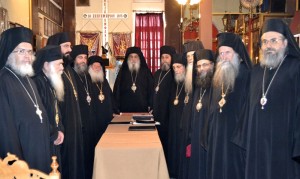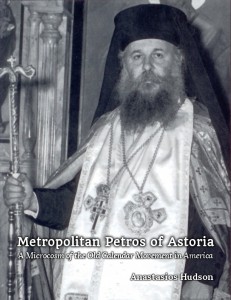My Joy Over the Recent Church Union
This week, traditional Orthodox Christians rejoiced as a 30-year division ended; the Synod in Resistance united with the Church of the Genuine Orthodox Christians of Greece. This union is something I had prayed for and hoped would happen, but the many obstacles to it made me think that it would only be a dream. I had worried as well that maybe only part of the Synod in Resistance would unite with us, or perhaps some of our bishops would not accept the union, but in the end, all twenty-six bishops have entered into full communion with each other, forming one Synod that already has been administratively integrated.
Any historical, canonical, or dogmatic analysis of the Union would be interesting on its own merits, but as I often do on my blog, I would like to offer some reflections from a personal angle. From the beginning of my investigation into Orthodoxy around 1998, I was aware of the Old Calendarists and their positions regarding ecumenism and the Church Calendar, and I was always attracted to them; however, it would be some years before I would conclude that I also needed to become a part of the Old Calendar Church. My research at that point was primarily via the Internet, because in Raleigh, North Carolina, there were no Old Calendarists at the time.
When I moved to New York in August 2002 to study theology at St. Vladimir’s Seminary, I began to visit various parishes of every Orthodox jurisdiction, as I was looking for my permanent Church home. I also investigated the Old Calendarist parishes in the area gradually. In addition, our seminary library had an extensive collection of periodicals, including almost every back issue of Orthodox Tradition, the journal published by the Center for Traditionalist Orthodox Studies, which was the English-language publishing house of the Synod in Resistance. I read them all, and got a good feel for the Synod in Resistance and its positions.
I was beginning to prepare for my thesis at seminary, and naturally I decided to do it on something related to Old Calendarists, as I had already spent so much time studying them. I remember writing to Etna and inquiring about their position vis-à-vis the so-called Synod of Milan, whose founding bishop had been a co-consecrator of Archbishop (now Metropolitan) Chrysostomos of Etna. They replied in a polite but firm way that they would not engage in inter-Old Calendar polemic and wished me well.
Next, I began to correspond with Bishop Ambrose of Methone, because I was extremely impressed by the Synod in Resistance’s missionary work in Africa. By some reports, they had as many as 40,000 faithful in Congo, DR Congo, Kenya, and various other places. We have enjoyed now a ten-year occasional correspondence, although I have not written him in the past year or so. He always provided me with information and even sent me a signed photograph of Metropolitan Cyprian one time when I requested it. While I was gradually drawing closer and closer to joining the Church of the Genuine Orthodox Christians, whose American hierarch at that time was Metropolitan Pavlos, I still respected the missionary activities of the Synod in Resistance.
In 2005, I moved back to North Carolina, and I heard that Archbishop Chrysostomos would be in the Washington, DC area for a few months. I began contact with him in the hopes of arranging a meeting, which did not come to fruition. However, from that time, we have corresponded from time to time, and I have enjoyed his insights on various subjects.
On August 5, 2006 (n.s.), I was baptized into the Orthodox Church by Bishop Christodoulos at St. Markella’s Cathedral, and a few months later I was assigned to a business trip in San Jose, California. I made arrangements to visit St. Gregory Palamas Monastery in Etna, California and the Center for Traditionalist Orthodox Studies, which is centered there. After flying for around eight hours with a stopover in Texas, I arrived in San Jose, rented a car, and drove six and a half hours to Etna, where I arrived seventeen hours after leaving my house. I was exhausted, but taken to the Church, where a service was in progress. Afterward, Fr. Akakios, the abbot of the monastery, took me to the refectory and served me a delicious meal.
The next morning, there were services, and afterward, I was taken to my guest quarters and a few minutes later, there was a knock on the door. A monk delivered a cappuccino on a silver platter. He also gave me some theological texts and documents to read, which I did. Finally, I was granted an hour-long audience with Archbishop Chrysostomos and Bishop Auxentios, where we discussed many things, including my desire to see a union between the jurisdictions. My time spent at the monastery was a great pleasure, and I enjoyed meeting other Old Calendarists outside of my own jurisdiction.
While I chose to join the Church of the GOC because I accepted its historical and canonical arguments, and eventually its ecclesiological position, I always maintained a great deal of respect for the Synod in Resistance for its theological texts, presentations, missionary work, and my personal contacts with its bishops. Seeing this union of their bishops with ours has raised my spirits greatly this week.
When people look at the Old Calendarists from the outside, they initially see various groups with lots of infighting; while it was relatively straightforward for me to go through the various claims and make a decision as to who was ultimately “right,” it was not always so easy for others, especially those living further away from any parish or institution, and as such, the divisions were more troublesome to them and certainly have kept some from joining our Church. In addition, while the division did not weaken my conviction that the Old Calendar Church is the true Church, seeing the divisions caused me a great deal of heartache. The obliteration of this division has eliminated one of the great stumbling blocks for those looking in to the Old Calendar Orthodox Church, and I rejoice in that.
The way forward is filled with great possibilities. Having so many more bishops in the Synod will make its work run more efficiently. Having more parishes and more priests will increase the number of people who are able to encounter Orthodoxy the way most people still come into contact with it: by being invited to a parish by their friends or family. Our Three Holy Hierarchs School can begin to collaborate with the Center for Traditionalist Orthodox Studies to increase the educational opportunities available to our priestly candidates. The union with the Synod in Resistance’s sister Russian, Romanian, and Bulgarian Churches will increase the catholic witness of our faith. May the Lord be praised!




Bishop Ambrose also helps Fr. Gregory Williams with the Haiti Mission.
Fr. Gregory sent out the photos of the concelebration pointing out Bishop Ambrose and saying, in parentheses, that Bishop Ambrose was “undoubtedly one of the chief, behind-the-scenes, architechts of this union.”
(He is a living saint.)
Thank you for the information, Joanna! I had forgotten about Bishop Ambrose’s trip(s) to Haiti. May our African and Haitian bretheren grow to the point that one day they may have their own bishops, too!